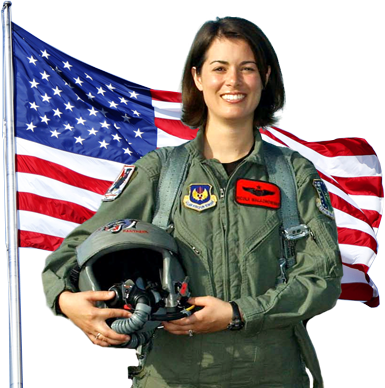- Details
- Hits: 910
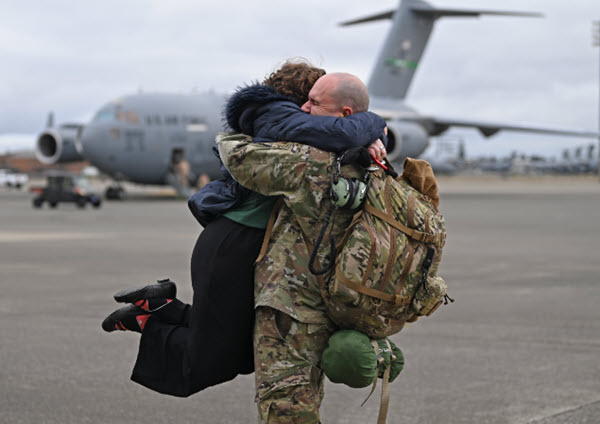
Joint Base Lewis-McChord, Washington.(April 4, 2023):In this photo by Senior Airman Callie Norton, Master Sgt. David Schnabel, 8th Expeditionary Airlift Squadron first sergeant, is welcomed home from a deployment by a loved one at Joint Base Lewis-McChord. The deployment was the 62nd Airlift Wing’s first under the new Airforce “Force Generation Model” in support of U.S. Central Command, U.S. European Command, and U.S. Africa Command operations. The Force Generation Model is a new policy to make servicemember deployments more predictable and scenes like the reunion above, while touching, happen less often.
Airforce personnel and their equipment are fatigued after decades of war around the world and Airmen need a more stable deployment schedule to allow time for family life. In the past, the Airforce deployed forces to military commanders around the globe continuously which has become unsustainable due to its impact on crew training and readiness. The new program allows Airmen to get ready for deployment year-round rather than scramble to complete training and preparation at the last minute.
The Airforce has created a cyclical process that rotates Airmen through four phases, “Reset, Prepare, Ready, and Available To Commit. In the Ready phase, multiple units gather for training events and hold competitions, such as flag events, weapons school, or other large-scale exercises that keep units at a razor’s edge. This is followed by the Prepare phase that spreads out training across 18 months before they can be assigned overseas. Next comes the Ready phase, the final preparation step before a unit is declared “Available to Commit” anywhere in the world.
- Details
- Hits: 1136
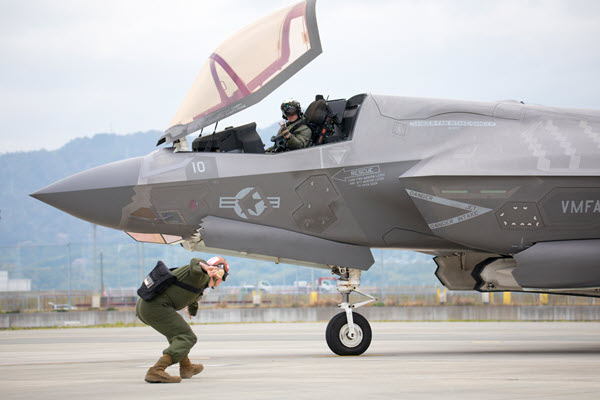
Iwakuni, Japan. (April 7, 2023): In this photo by Corporal Tyler Harmon, fixed wing aircraft mechanic Lance Corporal Herbert Tunley III signals to pilot Major Douglas Kansier, F-35B Lightning pilot and executive director of Marine Fighter Attack Squadron 242 during flight operations in the Indo-Pacific. This remarkable aircraft is the backbone of American combat aviation and will represent the bulk of the crewed tactical aircraft of the U.S. Air Force, Navy, and Marine Corps for several decades to come.
The Lockheed Martin F-35 Lightning II is a single-seat, single-engine, all-weather stealth multirole combat aircraft that is intended to perform both air superiority and strike missions. It is also able to provide electronic warfare and intelligence, surveillance, and reconnaissance capabilities as needed.
The aircraft comes in three versions, the conventional takeoff and landing F-35A, the short take-off and vertical-landing F-35B, and the carrier-based F-35C.
The Marine variant pictured above is a short take-off and vertical landing jet able to take off from a short runway (or take off vertically if it does not have a heavy payload) and land vertically (i.e. with no runway). Incredibly, the F35-B can clear a 50-foot obstacle and needs only 1,500-foot runway to takeoff. Designed to operate from remote expeditionary airfields or within range of air-capable ships, the F-35B features a vertical lift fan and pivoting engine nozzle to deliver vertical landing virtually anywhere a landing strip can be constructed.
- Details
- Hits: 1350
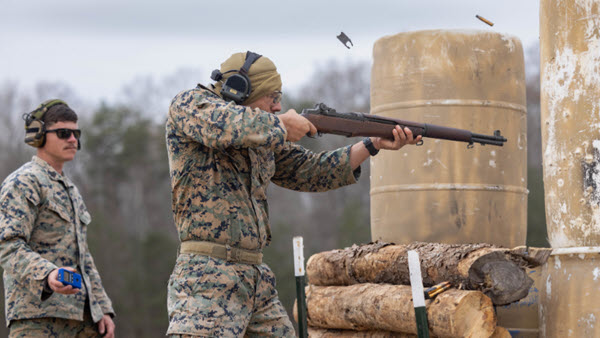
Marine Corps Base Quantico, Virginia. (April 12, 2023): In this photo by Corporal Mitchell Johnson, Marine Corps Sergeant Steven Gomez, a small arms repair technician with Weapons Training Battalion, fires a World War II vintage French M1 Grand rifle during Marine Corps Championships at Quantico, Virginia. Marines who place in the top ten percent in marksmanship during unit competition are invited to participate in the Marine Corps Championships, a ten-day contest in precision rifle, pistol, and multi-gun action shooting to see which unit has the sharpest marksmen in the Marine Corps.
Quantico is affectionately known as the “crossroads of the Marine Corps” in that no other base touches virtually every aspect of the Corps. The base is primarily used for training and hosts the USMC The Basic School, Officer Candidates School, Marine Corps University, Weapons Training Battalion, and the FBI Academy.
The Commandant of the Marine Corps established Quantico on May 14, 1917, and thousands of Marines would be trained there before World War I. The goal at that time was to make Quantico “and the whole Marine Corps a great university.”
- Details
- Hits: 1165
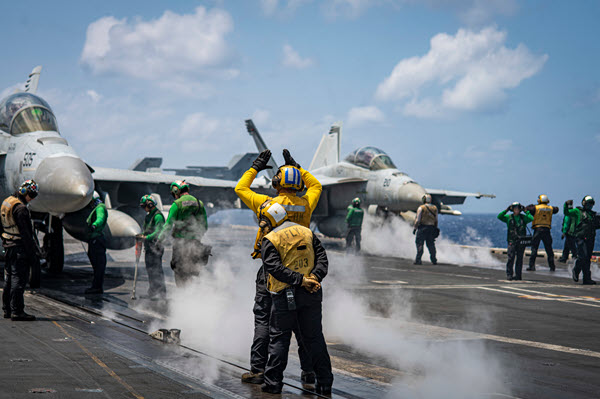
Philippine Sea. (April 10, 2023) Few modern movies open with a more dramatic scene than Top Gun 1986 with iconic images of Sailors preparing to launch the F-14 Tomcat. Clouds of steam billowing around their ankles, navy crews their final checks before receiving a sharp salute from Tom Cruise whose Phantom screams off the deck. For civilians, launching and recovering aircraft aboard a moving aircraft carrier at sea must be the most complicated and dangerous operation imaginable.
In this photo by MC3 Hannah Kantner, Sailors perform a complicated dance to prepare aircraft for flight operations on the flight deck of the aircraft carrier USS Nimitz. The Nimitz is part of the U.S. 7th Fleet and is the Navy's largest forward-deployed flotilla. The 7th Fleet operates with our allies and partners in the Indo-Pacific region.
In the “dance”, each Sailor (identified by color) does their part in a highly choreographed, and dangerous, process where every action must be in perfect sync. The Air Boss, perched above the flight deck, controls every movement on a carrier from helicopters to jet fighters, five nautical miles out from the carrier.
Read more: USS Nimitz… CARRIER SAILORS DO “COMPLICATED DANCE”
- Details
- Hits: 1106
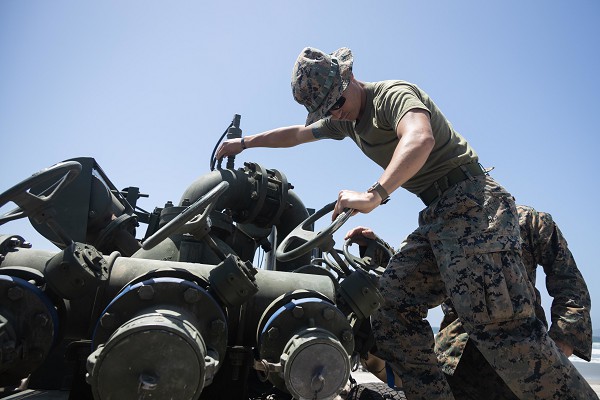
Camp Pendleton, California. (April 5, 2023): In this photo by Sergeant Maximiliano Rosas, Corporal Benjamin McDonald, a bulk fuel specialist with Bulk Fuel Company, 7th Engineer Support Battalion, 1st Marine Logistics Group pumps excess seawater out of a liquid “bladder” during tactical operations on Silver Strand Beach, California.
Bulk Fuel Specialists install, operate, maintain, and repair fuel handling units and accessory equipment and test petroleum products used in amphibious assault vehicles. They are experts at hazardous materials management, and they test petroleum products to evaluate their quality. These professionals are responsible for refueling everything, from automobiles to jet aircraft, following strict safety protocols.
While the position of Bulk Fuel Specialists may not seem that glamorous, the mission they perform can easily decide the outcome of a battle. After all, what good is it for courageous Marines to seize a beachhead or liberate an airfield if you cannot get fuel, water, ammunition, and food to the troops and their vehicles. In fact, the 7th Engineer Support Battalion, also known as “Big Red”, has been so vital to military success that it has participated in the Viet Nam War, Operation Desert Shield/Storm, Operation Iraqi Freedom, and the war against terror in Afghanistan.
Today, Marine planners estimate that an expeditionary force would use 1.2 million gallons of fuel a day when conducting amphibious landings. Without experts at handling, storing, and distributing this precious commodity, even the finest military cannot succeed.
- Details
- Hits: 962
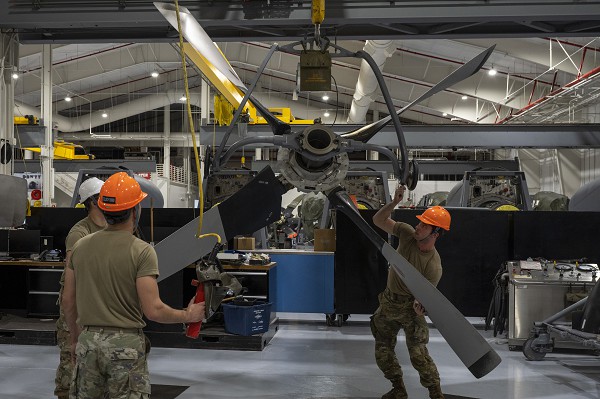
Hurlburt Field, Florida. (April 5, 2023): In this photo by Airman 1st Class Hussein Enaya, Airmen assigned to the 1st Special Operations Maintenance Squadron remove the rear spinner of an MC-130H Combat Talon II at the Squadron Central Repair Facility at Hurlburt Field, Florida. The Squadron is responsible for maintaining combat-capable aircraft and equipment for Air Force Special Operations Command missions.
Their motto, “Any Time, Any Place”, accurately describes the mission of these highly specialized teams of more than 650 active duty and civilian mechanics and engineers who service and repair a variety of special mission aircraft.
The Squadron operates a Centralized Repair Facility to address problems unique to Air Force Special Operations Command. These highly secretive missions require unique avionics, electronic warfare components, and flight controls. They also provide crash recovery and emergency response for the airfield and surrounding communities.
Read more: 1ST SPECIAL OPERATIONS MAINTENANCE SQUADRON “ANY TIME, ANY PLACE”


